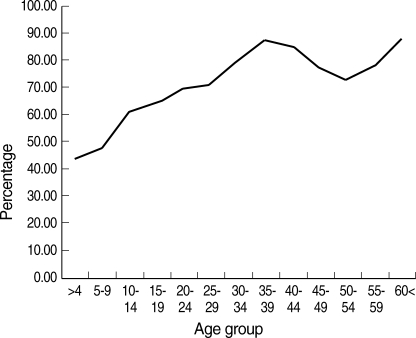Toxoplasma gondii infection has shown considerable prevalence in Iran [1]. There were studies on Toxoplasma infection in Iranian communities from many different points of view. Ghorbani et al. [2] reported in 1978 their first seroepidemiologic studies in a southwestern part of Iran. Later many other seroepidemiological studies were conducted by Agha-Miri in south of Iran [3]. Shemirani [4] determined the Toxoplasma infection rate in outpatients referred to a gynecology clinic in south of Tehran (4). Sharif et al. [5] studied this infection in mentally retarded handicaps, and Fallah et al. [6] determined the prevalence of infection in primigravida women in Hamadan, but there was little publication about general prevalence of Toxoplasma infection in Tehran. We conducted the present study to determine the prevalence of Toxoplasma infection in Shahr-e-Rey area, south of Tehran. There were several studies about Toxoplasma infection in Iranian communities, but no study in general population in Tehran, the capital of Iran, is seen.
The present cross sectional study was based on systematic cluster sampling in different social and demographic groups in Shahr-e-Rey area. By using local health center files, a total of 1,187 cases were selected randomly. These health centers were as follows: Badr Urban Health Center, Doulat-Abad Urban Health Center, Nick-Nejad Urban Health Center, Ghuch-Hesar Rural Health Center, Bagher-Abad Rural Health Center, and Shur-Abad Rural Health Center. In these centers, health services are performed actively and these active services made it easy to find cases for our study. For each case general information and demographic data were saved before sampling. The data included age, sex, occupation, literacy, family dimension, keeping animal, water supply condition, and nutritional behaviors. Each of blood samples was collected in 3 hematocrit tubes and transferred in a cold box to the laboratory of Parasitology, Tehran University of Medical Sciences. After centrifugation, the serum samples were examined by an IFA technique, and the results were added to the general data sheet. Antigens were prepared from T. gondii RH strain in the above mentioned laboratory and whole anti-human antibody conjugate was used for florescence. Dilution of sera was determined as 1 : 10, 1 : 100, 1 : 200, 1 : 400, 1 : 800, 1 : 1,600, and 1 : 3,200. In this study, 1 : 10 titer was considered as positive [7].
The results showed that 68.4% of cases in different communities had serum titers of 1 : 10 or higher, and the rate was 30.2% for 1: 400. The negative rate was 31.6%. Table 1 shows more details on these titers. Although there is a correlation between age and prevalence of infection in different age groups (P = 0.001), there was a descending curve in the age group of 40-50 years. Table 2 and Fig. 1 show this phenomenon; ascending curves showing high risk ages are seen at the age group of 10-14 and the age group of 30-39. Sex and Toxoplasma infection had also a correlation; the infection was significantly higher in women (P = 0.00) than men. Table 3 shows higher prevalences in females; according to our findings 80.2% of positive cases were females and less than 20% were males, whereas in negative cases the distribution was not highly different (56.5% in females and 43.5 in males). Occupation and Toxoplasma infection showed significant correlations (P = 0.008), and social reasons forced us to classify the occupations into 3 groups, i.e., mental activities (teachers and students), manual activities (workers, farmers, and housewives), and other occupations (unemployed and others). Many other variables were checked in this study. These included history of keeping dogs, cats, chickens, domestic birds, pigeons, history of lymphadenitis, ocular disorders and abortion, nutritional behaviors (routine consumption of raw vegetables and junk food), residential status (living in a house or an apartment). However, there was no significant correlation between Toxoplasma infection and these parameters.
Comparing with other researches in which the titer 1 : 20 was considered as the positive cut-off point, our study showed a 68.4% prevalence in general population in south of Tehran. This finding is well correlated with Shemirani [4] who found 55% prevalence of Toxoplasma infection in women referred to labor section of 2 gynecology clinics in south of Tehran. Assmar et al. [1] reported 51.8% prevalence in general population of Iran [1]. Ghorbani et al. [2] showed 55.7% prevalence in a rural area in northern Iran. Studies have shown increases in the prevalence of Toxoplasma infection in Iran. In Khuzestan province, South-west Iran, Ghorbani et al. [8] reported 17.7% prevalence in 1977, and Agha-Miri [3] reported 44.5% prevalence in 1993. According to Agha-Miri [3], the prevalence of Toxoplasma infection in south of Iran, from southwest to mid-south was between 42.7% and 44.5%. On the other hand, Toxoplasma infection was more prevalent among immigrants [9]. Most people in Shahr-e-Rey area are immigrants, and thus Toxoplasma infection was high; this corresponded well with findings in Malaysia [9]. Hershey and McGregor [10] showed that Toxoplasma infection was more prevalent in low altitude areas. This is also corresponded well with the low altitude of Shahr-e-Rey comparing with other parts of Tehran. Although Jackson et al. [13] did not find significant correlations between infection and sex, there were biological [12] and epidemiological evidences generally showing a high prevalence in the male gender [13]. According to Ghorbani et al. [2,8], there were significant correlations between Toxoplasma infection and sex in Azerbaijan province and age in Gilan province, which were compatible with the results of the present study. The present study included most women in pregnancy ages, and they were considered already infected. Since the infection occurs in early years of life, more attention should be paid in this protozoan infection.







